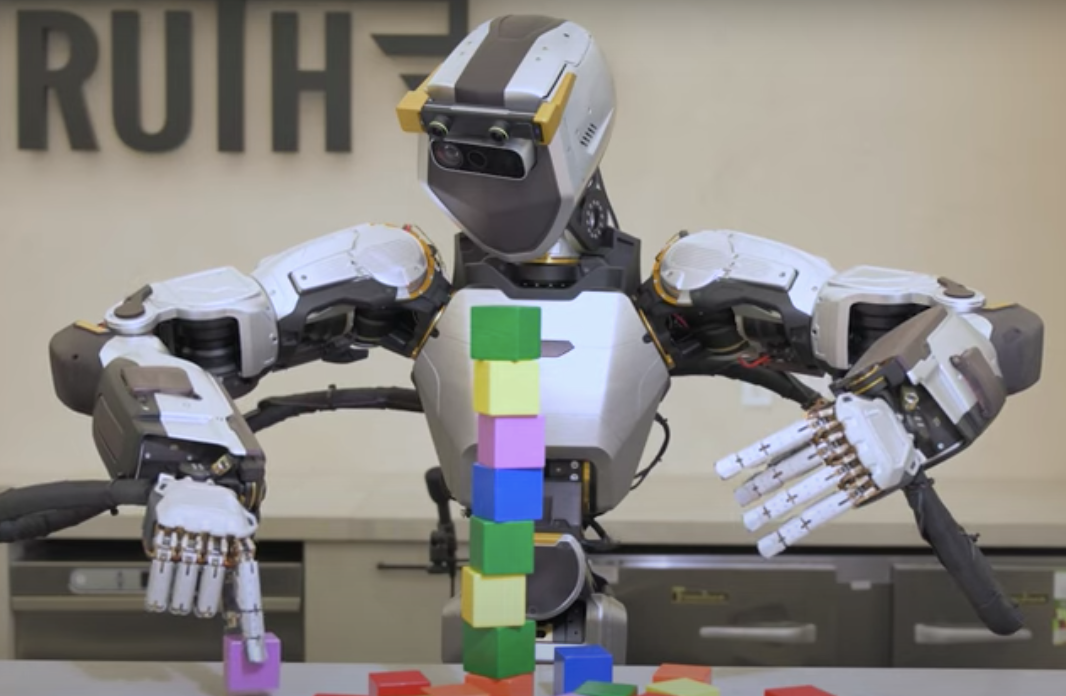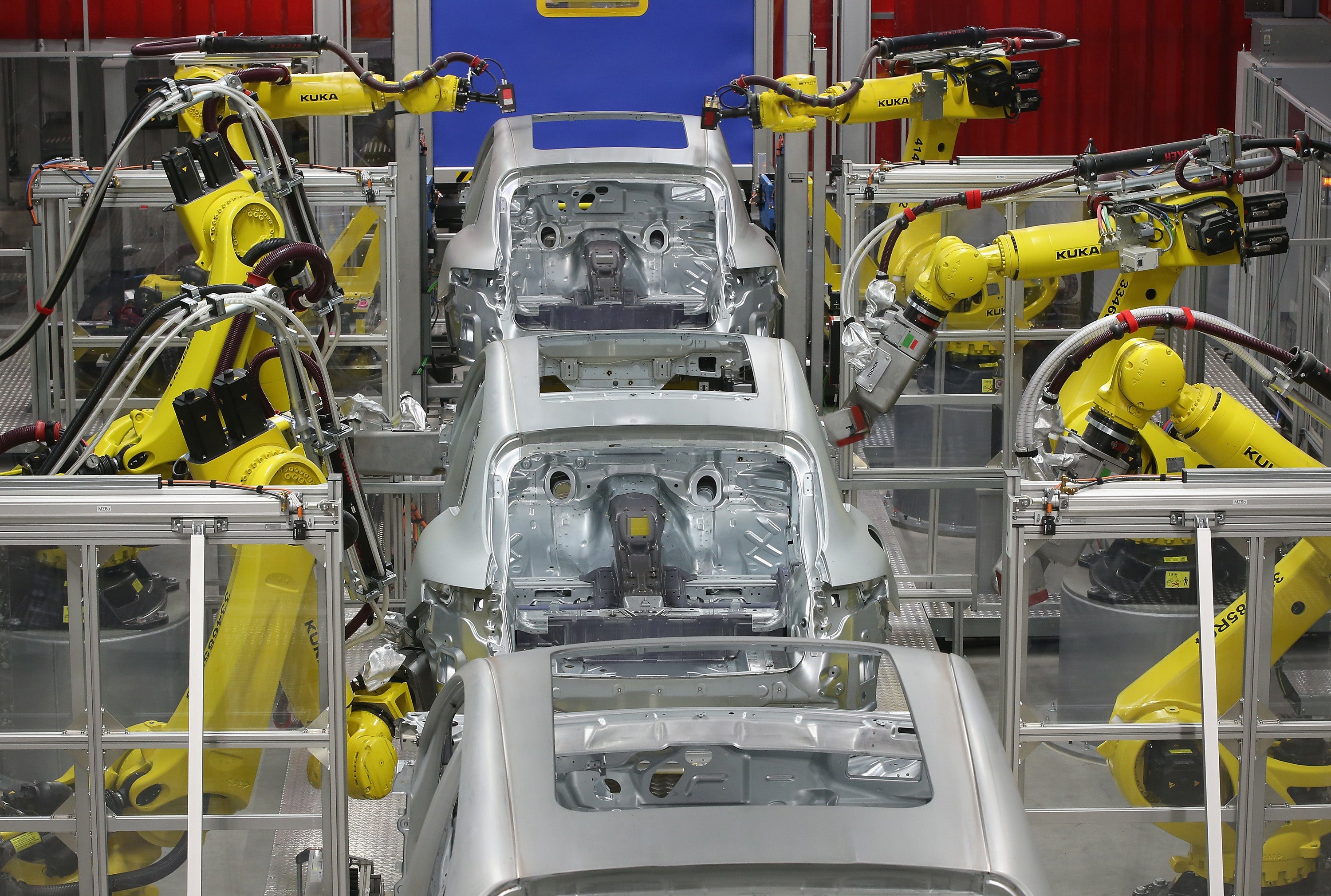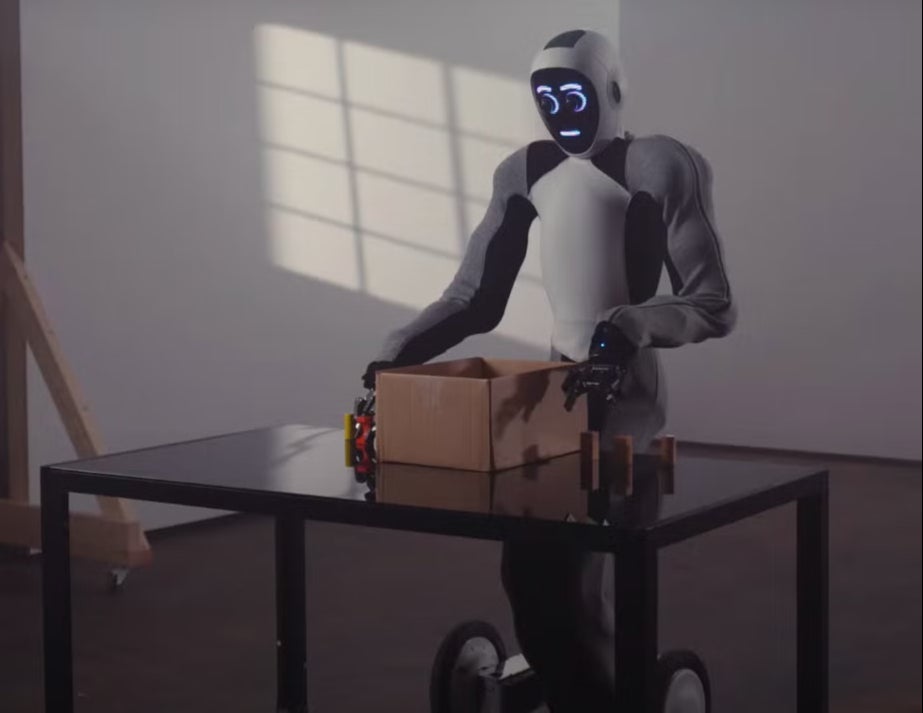The Independent's journalism is supported by our readers. When you purchase through links on our site, we may earn commission.
Meet the AI human-like robots that can do our jobs
Current breakthroughs in AI are key to the revolution in ‘human’ androids, explains Robert Waugh. Some of them are already employed

The idea of a humanoid robot that can do the work of human beings dates back almost 3,000 years to the Iliad, in which the god Hephaestus was assisted by his own metal creations. But now, in 2023, the concept is becoming reality.
A robotics start-up funded by OpenAI, the company behind ChatGPT, is employing EVE robot devices as security guards in Europe and America – with human operators able to “step inside” the “body” using virtual reality.
Elon Musk’s Tesla is also working on its own robot, Optimus, which Musk believes “could be more significant” than the company’s car business over the long haul.
Goldman Sachs has predicted that humanoid robots could be a $150bn (£114bn) a year market within 15 years – and that humanoid robots could be working in factories by 2025.
By 2030, Goldman Sachs believes that robots could fill 4 per cent of the projected US manufacturing labour shortage – and in a “blue sky” scenario, humanoid androids could fill 126 per cent of the labour gap. Sachs predicts that humanoid robots will be economically viable in factories by 2025 to 2028, and in consumer-facing jobs between 2030 and 2035.
Musk, who has also said that AI is more dangerous than nuclear weapons, says that the Tesla bot will eventually be able to do anything that humans can, and has claimed it will go into production this year.
Another robot, Phoenix, has already worked in a tyre shop in Canada, and performed 110 “human” tasks correctly including packing merchandise, tagging, labelling and folding. Other robots such as Robo-C are built to work in customer service in shops, and 1X has tested robots for use as carers.
The companies behind the technology argue that the robots won’t “take human jobs” – but will instead address shortages in the labour market around the world, particularly in physical labour, and over the long term will compensate for declining birth rates.
Videos of Sanctuary AI’s humanoid robot show it picking up, sorting and stacking objects. Phoenix is built to work and “think” like a human being – and will be able to respond to voice commands.

Unlike the robots used widely in industry, Phoenix is built to do any job, rather than a single one. Making single-purpose robots has been a “trap” for robotics companies, says Geordie Rose, CEO and co-founder of Sanctuary AI.
“Unlike many AI and robotics companies, Sanctuary AI is focused on addressing the massive labour shortages that organisations are facing around the world,” he says. “Because our robots are designed to act, move, and think like people, these robots can be used across industries and geographies to fill job vacancies, perform dangerous tasks, and augment the human workforce.”
One key breakthrough enabling the new generation of androids is hands that can pick up objects delicately. The hands of the robot “rival human hands” in their dexterity and lightness of contact, Rose believes. This means that Phoenix can, for example, put groceries in a plastic bag. A “haptic” – vibration – technology gives Phoenix a sense of touch.
“Given that more than 98 per cent of all work requires the dexterity of the human hand, one can’t create a truly useful humanoid robot without human-like hands,” he says.
The robot stands at five foot seven inches and can move at three miles per hour.
Rose argues that humanoid robots like Phoenix will become increasingly necessary as the world is dealing with declining birth rates and an ageing population, resulting in a massive labour shortage. The US alone is currently facing 9.8 million job vacancies, but has only 5.9 million unemployed workers.
Previous generations of robots have been highly effective but limited to one very specific job. For example, a manufacturing robot might be designed to move a car chassis following a very precise and specific pattern.

But rather than having single-purpose robots executing one task extremely well, the businesses of the future will need robots capable of doing any job, Rose believes.
“We’re building a robot that can do any work a person might be reasonably expected to do,” Rose says. “And not because we can, but because we believe we must.”
Phoenix is given “human-like” intelligence by an AI software system called Carbon – enabling the robot to respond to commands in English, and complete tasks under its own steam.
The company is “immensely proud” of the robot, Rose says, but the “real star of the show” is the underlying software.
The journey to humanoid robots has been long and bumpy. Honda set out to create a bipedal walking robot in 1986, and it was 10 years before it unveiled the P2 prototype of its robot Asimo, who became something of a global celebrity thanks to appearances at tech shows and other events.
Honda hoped that the robot would become a personal assistant who could live in human households, with Satoshi Shigemi, who worked on Asimo, saying he hoped it would become a “primary school kid who starts helping out around the home”.
The robot made its last active appearance in March 2022, never having gone on sale (although it once kicked a football to Barack Obama).
Current breakthroughs in AI are a key factor helping to power the revolution in humanoid androids – with people able to command the droids in natural English, in the same way they interact with apps such as ChatGPT, says David Ciccarelli, founder and CEO of AI voice technology company Voices.ai.
“The landscape is transforming, with today’s androids vastly more sophisticated than those from previous decades,” Ciccarelli observes. “They’re not just handling physical tasks, but with advanced programming, they’re tackling complex tasks once thought to be uniquely human.” Ciccarelli points to another humanoid robot – Robo-C2 from Promobot – which is capable of natural conversations and could be used in customer service in shops. Unlike EVE and Phoenix, its face is made to look human-like, and the company boasts that it can “express emotions” and look like any person, real or fictional.
“The AI boom and humanoid robots go hand in hand,” Ciccarelli believes. “As we refined an AI model for voice recognition at Voices.ai, it was fascinating to see the system picking up human speech nuances, demonstrating AI’s potential to empower humanoid robots in reshaping our workplaces.”
Rapid advances in AI, along with information harvested from sensors, will enable robots to work in teams alongside humans or other robots, says Atif Azad, professor of artificial intelligence at Birmingham City University.
“AI techniques such as deep learning have revolutionised critical tasks such as recognising objects and identifying their different instances, understanding speech and natural language, and interpreting human gestures accurately,” Azad points out.
In the workplace, robots will harvest information from nearby computer systems and sensors to enable them to work alongside human “colleagues”, Professor Azad believes.
Companies in the AI space are investing in robotics. Norwegian start-up 1X was funded by ChatGPT maker OpenAI’s start-up fund, meaning that the company has early access to OpenAI technology.
The company’s CEO, Bernt Bornich, has described the robots as “embodied AI”.

The android EVE has been built from the bottom up to work much like a human body does, with synthetic ropes like muscles and tendons within the robot – enabling it to pack boxes in a manner eerily like a human being. The technology means that the robot can control its own strength, and is unlikely to break things or kill bystanders – which Hege Nikolaisen, head of communications at 1X, says has been one of the key barriers preventing the wider use of humanoid robots.
The first man killed by a robot died in 1979 in a Ford factory, crushed by a one-tonne transfer vehicle. A significant obstacle to creating robots has been in developing technology that is safe enough to move out of a factory setting, says Nikolaisen
“We’ve all heard for years that robots will soon come to work for us, but it’s never actually happened until now,” she says. “Our androids use strong, but energy-efficient motors so that they can safely interact with their surroundings without the combination of high speed and force causing damage to the surroundings.”
The EVE robot can pick up and interact with objects and is already working as a security guard in two facilities – one in Europe and one in America, Nikolaisen says. It’s controlled by human guards via virtual reality when needed (for example, if there’s a security incident).
Most of the time, however, it travels around the facility it is guarding under its own steam: it can open doors and even ride lifts, pressing buttons using its robot “hands”.
One guard can control multiple EVE robots.
“A security guard sitting at a control centre operates a fleet of EVE androids that autonomously patrols and navigates a commercial building,” Nikolaisen explains. “If there is an irregular event or the operator sees a need to perform a task; she or he uses the sync mode to teleoperate the robot using goggles and controllers to take control of the android’s vision and body. You can then bend, grip, look or communicate in telepresence using the android.”
The company hopes that the robots can be used in many different industries.
“The androids can be used for monitoring, logistics, retail and/or warehouses,” Nikolaisen says. They can perform typical boring and repetitive tasks such as packing, sorting, moving, printing, cleaning or monitoring.
“Within a couple of decades, we believe it will be possible to use androids as personal assistants.”
Going forward, today’s rapid AI growth is likely to happen in parallel with a boom in humanoid robots – with natural-language robots powering discoveries that also feed into AI, believes Ciccarelli.
“The advancements in AI have made it possible for these robots to understand and navigate their environment, recognise objects, and perform complex tasks,” he points out. “The continued development of these robots will likely contribute to the ongoing AI boom, as they will generate new data and use cases that can further advance AI research and applications. One pushes the other forward, creating a self-reinforcing cycle of progress.”
Join our commenting forum
Join thought-provoking conversations, follow other Independent readers and see their replies
Comments
Bookmark popover
Removed from bookmarks